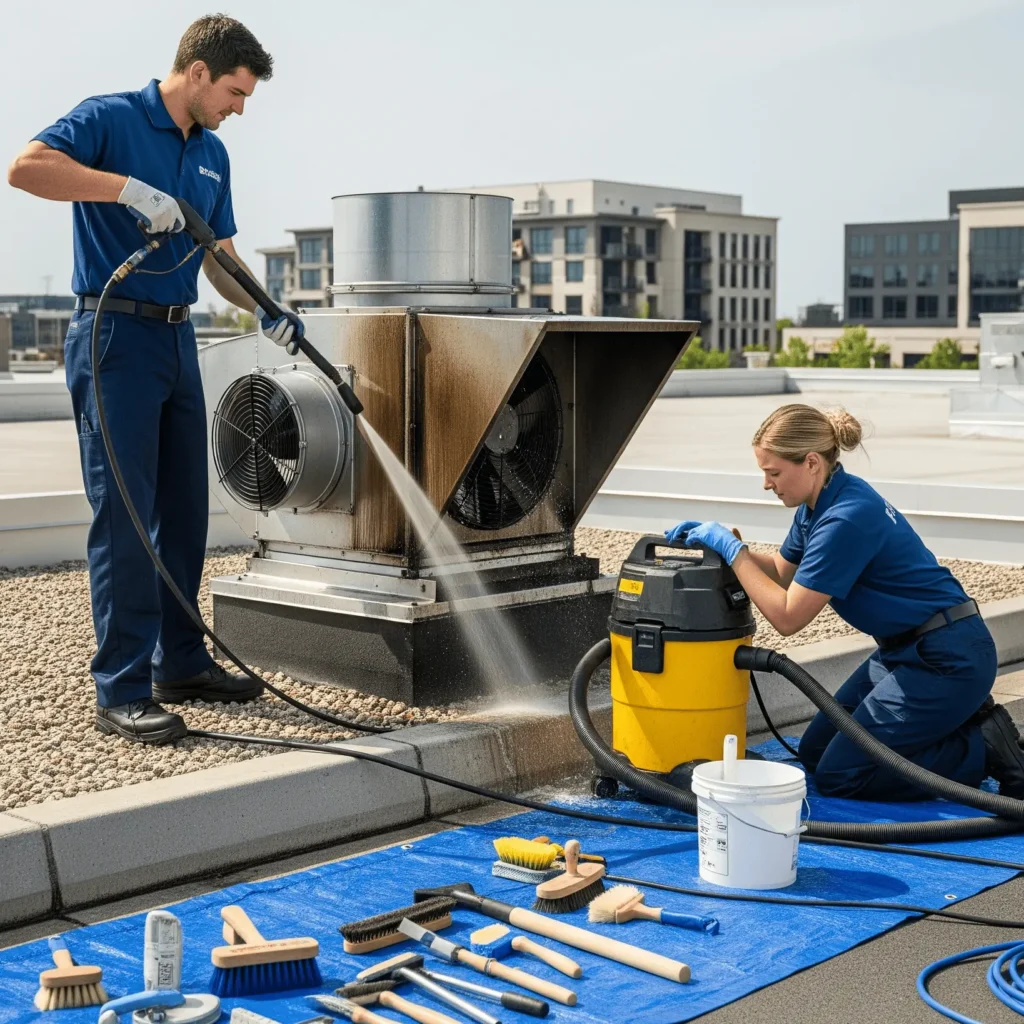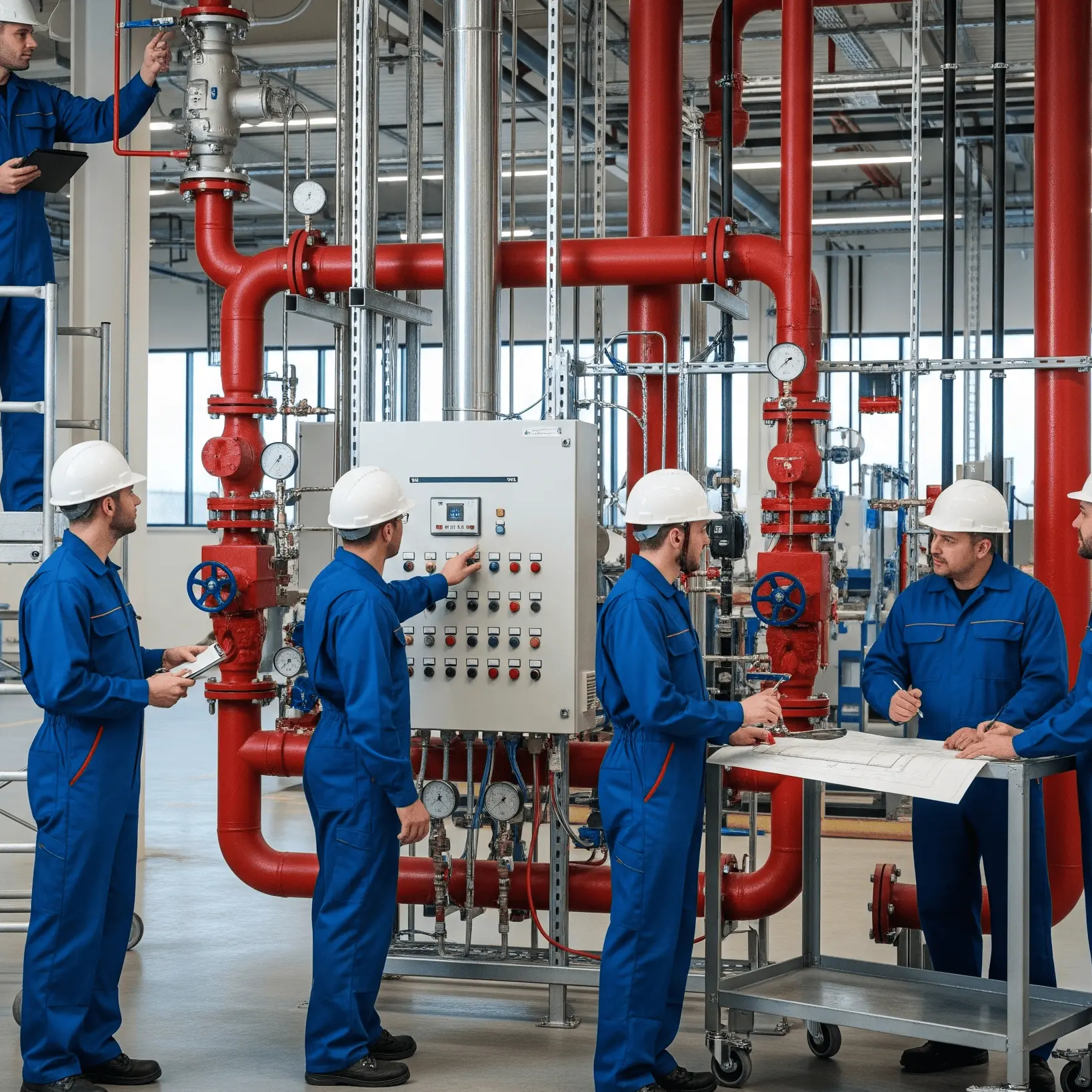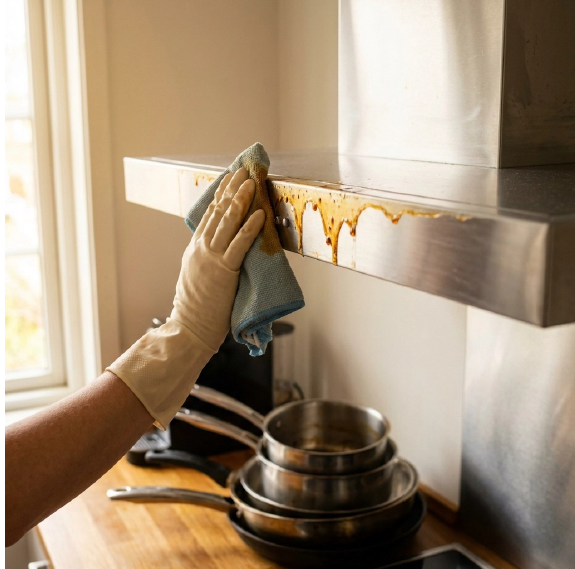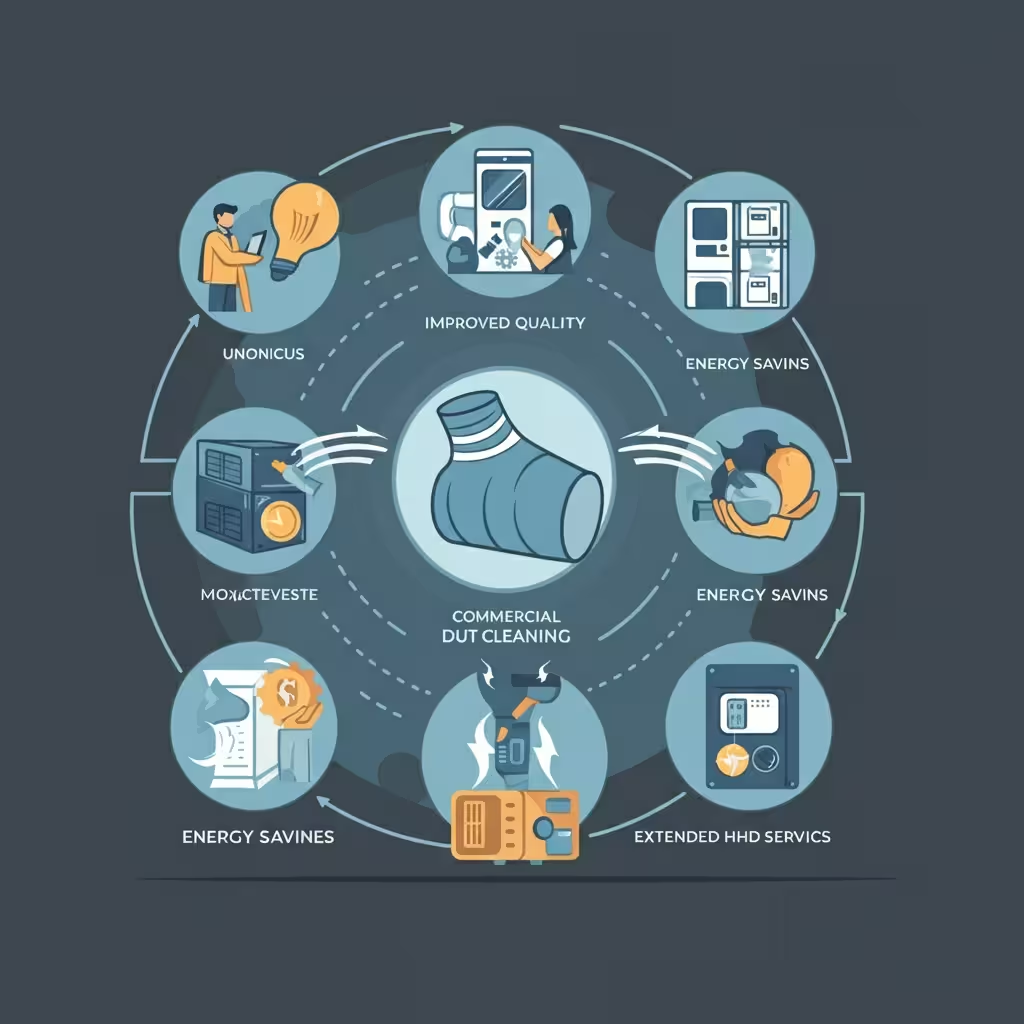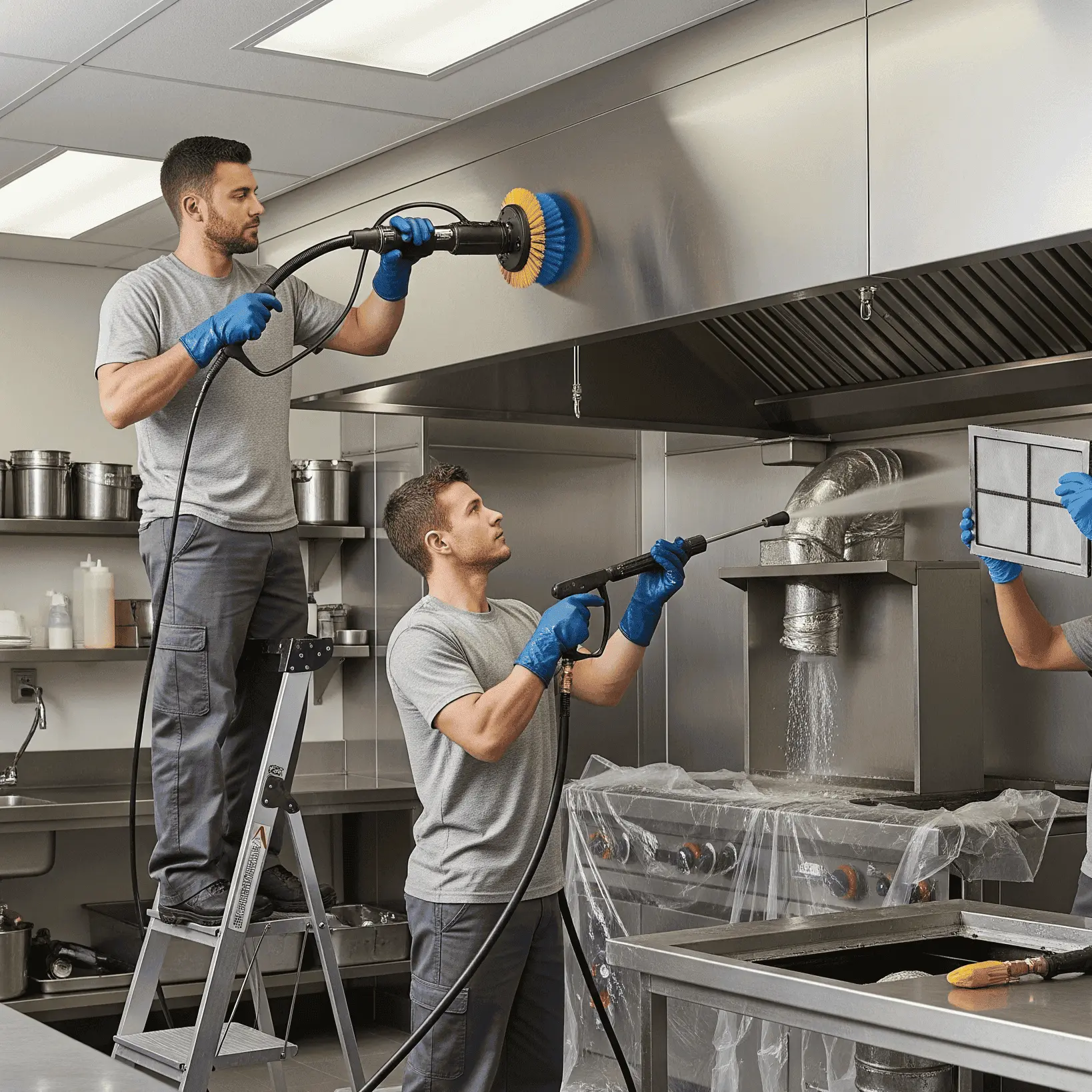The sizzle of onions hitting a hot pan, the roar of the grill, the tantalizing aromas that fill the air—these are the signs of a thriving commercial kitchen. But lurking above the controlled chaos of the cook line is a hidden danger that many Illinois business owners overlook: the kitchen exhaust system. A dirty, grease-laden exhaust system isn’t just a matter of cleanliness; it’s a critical fire hazard and a compliance nightmare waiting to happen.
This comprehensive guide will walk you through everything Illinois restaurant owners, facility managers, and food service operators need to know about professional kitchen exhaust cleaning. We’ll cover why it’s essential, what the law requires, and how to ensure your establishment is safe, compliant, and efficient.
What is a Kitchen Exhaust System and Why is Cleaning it Crucial?
Before diving into the “why,” let’s understand the “what.” Your kitchen exhaust system is more than just the shiny hood above your cooking equipment. It’s an integrated ventilation system with several key components:
- Kitchen Hood: The canopy that captures the heat, steam, and grease-laden vapors rising from your cooktops.
- Grease Filters: The first line of defense, designed to trap a percentage of airborne grease particles.
- Ductwork: The network of hidden channels that transports the hot, greasy air from the kitchen to the outside.
- Exhaust Fan: Typically located on the roof, this is the powerhouse that pulls air through the entire system.
As you cook, microscopic particles of grease are vaporized and pulled into this system. Over time, they cool, solidify, and accumulate on every surface, creating a thick, sticky, and highly flammable substance. This buildup is the primary fuel for devastating restaurant fires.
Cleaning this system is non-negotiable for several critical reasons:
- Unmatched Fire Prevention: The U.S. Fire Administration reports that thousands of restaurant fires occur each year, with cooking equipment being the leading cause. A clean exhaust system removes the fuel source, drastically reducing the risk of a small flare-up turning into a catastrophic blaze that travels through your entire building.
- Compliance with Illinois Regulations: Fire marshals and health inspectors across Illinois enforce strict codes. Failure to maintain a clean system can lead to hefty fines, forced closures, and even legal liability.
- Improved Kitchen Air Quality: A clogged system can’t effectively remove smoke and odors. This leads to poor indoor air quality, creating an uncomfortable and potentially unsafe environment for your kitchen staff.
- Enhanced System Efficiency: When components are caked in grease, the exhaust fan has to work much harder to move air. This strain increases energy consumption and leads to premature wear and tear on expensive equipment, resulting in costly repairs.
Understanding Illinois Fire Codes and NFPA 96 Standards
In Illinois, compliance for kitchen exhaust systems is primarily governed by the NFPA 96: Standard for Ventilation Control and Fire Protection of Commercial Cooking Operations. This is the national standard adopted by virtually all local municipalities and fire departments throughout the state.
NFPA 96 is very specific about the frequency of inspections and cleaning. The entire system—from the hood in the kitchen to the fan on the roof—must be cleaned by a properly trained, qualified, and certified company. The required cleaning schedule is based on the type and volume of cooking you do:
- Monthly: Required for systems serving solid fuel cooking operations, such as those using wood or charcoal.
- Quarterly (Every 3 Months): For high-volume operations like 24-hour restaurants, establishments that do a lot of charbroiling, or wok cooking.
- Semi-Annually (Every 6 Months): This is the most common frequency, applying to most moderate-volume restaurants, hotel kitchens, and hospital cafeterias.
- Annually (Once a Year): For low-volume operations such as churches, day camps, senior centers, or seasonal businesses.
Ignoring these standards not only puts you at risk of fines but could also void your insurance policy in the event of a fire.
What to Expect from a Professional Kitchen Exhaust Cleaning Service
A proper, code-compliant cleaning is far more than a quick wipe-down of the hood. It is an intensive, top-to-bottom process that leaves no part of the system untouched. A truly professional service ensures every inch of your system is cleaned “down to the bare metal.”
A thorough and certified cleaning process is exactly what we provide. You can learn more about our detailed approach on our Kitchen Exhaust Cleaning Services page.
Here’s what a professional service should involve:
- Preparation and Protection: Technicians will start by covering and protecting all cooking equipment, countertops, and floors below the hood with heavy-duty plastic sheeting to shield them from grease and water.
- Hood and Filter Cleaning: They will remove all filters from the hood, scrape away heavy grease deposits from the hood canopy, and then apply a food-safe degreasing agent to break down the remaining residue. The hood and filters are then typically cleaned with hot water pressure washers.
- Ductwork Cleaning: This is the most critical and often overlooked part. Certified technicians use specialized equipment, such as high-powered pressure washers with rotating heads and mechanical scrapers, to clean the entire run of ductwork, both horizontal and vertical.
- Rooftop Exhaust Fan Cleaning: The process isn’t complete without addressing the fan. Technicians will access the roof, disconnect the fan from the ductwork, and tip it on its side to gain full access. They will degrease and wash the fan blades, housing, and all accessible components to ensure it’s balanced and operating efficiently.
- Final Polish and Documentation: After cleaning, the technicians will dry and polish the hood, reinstall the clean filters, and clean up the work area, leaving your kitchen in better condition than they found it.
- Certification Sticker and Report: As proof of compliance, a certified sticker will be placed on the hood, indicating the date of service and the next recommended cleaning date. You should also receive a detailed service report, often including before-and-after photos, for your records.
Don’t Risk It: Why DIY Cleaning is Not an Option
While the temptation to save money by having your staff perform the cleaning is understandable, it’s a dangerous and ultimately costly mistake.
- Lack of Proper Equipment: You cannot clean a system to NFPA 96 standards with a bucket and a sponge. Professionals use industrial-grade degreasers and high-pressure hot water systems that are simply not available to the public.
- Inability to Access the Full System: Your staff can only reach the visible parts of the hood. They cannot safely and effectively clean the interior ductwork or the rooftop fan, which is where the most dangerous levels of grease accumulate.
- No Proof of Compliance: A DIY cleaning provides no certification. When the fire marshal or health inspector asks for proof of service, you will have nothing to show them. This documentation is crucial for your business license and insurance.
Choose a Certified Partner for Your Illinois Business
Your kitchen is the heart of your business. Protecting it from the risk of fire should be your top priority. Investing in a professional, certified kitchen exhaust cleaning service is not an expense—it’s an essential investment in the safety of your employees, your customers, and your livelihood.
Ready to ensure your Illinois kitchen is safe, clean, and fully compliant with state and national fire codes? Contact a certified professional today to schedule an inspection and protect what you’ve worked so hard to build.

